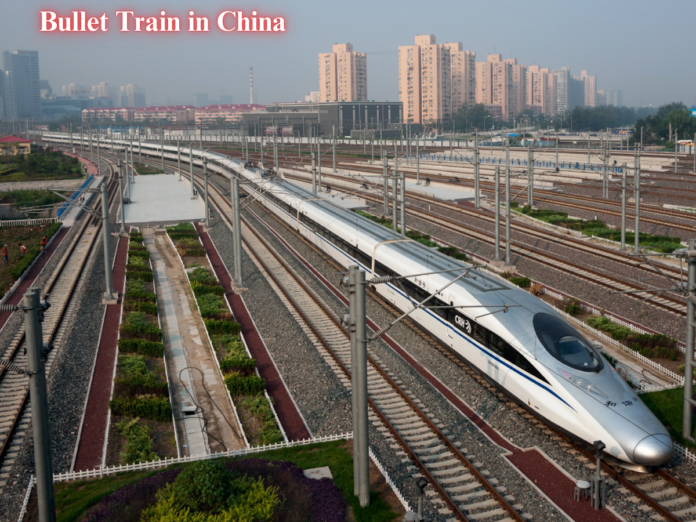China’s high-speed bullet trains have changed travel. They connect major cities quickly and reshape the nation’s transport. These modern trains show China’s tech and economic growth. They hint at the future of travel but also pose challenges.
History and Development
China’s high-speed rail system began in the early 2000s. It aimed to create a world-class transport network. The Qinhuangdao–Shenyang high-speed railway, opened in 2003, was the first major milestone. Inspired by Japan’s Shinkansen and France’s TGV, China quickly expanded its rail network. Key projects include the 2008 Beijing-Tianjin intercity railway. Also, the 2011 Beijing-Shanghai high-speed railway. These projects marked significant progress in speed and efficiency.
Technology and Infrastructure
China’s high-speed trains use advanced technology. Their engines power them at speeds of up to 350 km/h (217 mph). Some experimental models have reached speeds of over 400 km/h (249 mph). The trains are built to reduce air resistance. The infrastructure has carefully engineered tracks, bridges, and tunnels. Yet, building this infrastructure often harms the environment and local communities. It disrupts habitats and displaces people.
Current Network and Expansion Plans
China’s high-speed rail network, the largest globally, covers over 40,000 kilometers. It connects major cities, offering a convenient travel option for millions. Key routes include the Beijing-Shanghai line and the Guangzhou-Shenzhen-Hong Kong Express Rail Link. The government plans to expand the network to 50,000 km by 2035. However, there are concerns about the cost of extending it to less populated areas.
Speed and Performance
These trains typically operate between 300 km/h (186 mph) and 350 km/h (217 mph), ranking among the world’s fastest. Some trains have reached experimental speeds of over 400 km/h. This high performance comes from thorough testing and planning. However, there are debates about the safety of such high speeds in densely populated areas.
Passenger Experience
China’s high-speed trains are comfortable. They have economy to business class seats. Amenities include Wi-Fi, entertainment systems, and dining services. The booking process is user-friendly, with online platforms offering real-time updates. Beijing to Shanghai is a popular route. It offers scenic views and access to top tourist spots. However, fare increases and access in rural areas are ongoing concerns.
Economic Impact
The high-speed rail network has boosted China’s economy. It cut travel times and promoted business and tourism. Urban growth and higher property values followed development along major routes. However, high construction and maintenance costs pose challenges. So do concerns about financial viability in less populated areas. The economic benefits also vary, with wealthier areas gaining more advantages.
Environmental Considerations
High-speed trains use electricity, often from renewables. They use less energy and have a lower carbon footprint than cars and planes. However, constructing new lines can disrupt ecosystems and consume significant resources. Balancing rapid infrastructure development with environmental sustainability is a crucial consideration.
Safety and Security
China’s high-speed rail is very safe. It has automatic train controls and real-time monitoring. However, maintaining safety requires continuous investment and attention, especially as the network grows. Security measures, like passenger screenings and luggage checks, are vital. They protect against potential threats.
Challenges and Criticisms
The high-speed rail network faces challenges, including high construction and maintenance costs. There are concerns about the costs of expanding to less populated areas. People fear potential fare increases and the environmental impact of construction. Moreover, some criticize prioritizing high-speed rail over other public needs.
Future Innovations and Research
China is investing in faster trains, aiming for speeds over 600 km/h (373 mph). Efforts are also focused on improving energy efficiency and passenger comfort. China’s high-speed rail technology benefits from partnerships with Germany and Japan. However, there are questions about the practicality and safety of these advancements.
Cultural and Social Impact
The high-speed rail now connects cities with rural areas. It has changed lifestyles and boosted cultural exchange. For example, people can live in one city and work in another. Most see these trains as symbols of modernity. But rapid urbanization and a loss of tradition raise concerns.
Case Studies of Iconic Routes
The Beijing-Shanghai high-speed rail is very efficient. It connects two major cities in under five hours. The Guangzhou-Shenzhen-Hong Kong Express Rail Link facilitates cross-border travel and is strategically important. These routes show the pros and cons of adding high-speed rail to China’s transport network.
Comparison with Other Countries
China’s high-speed rail system is notable for its scale and rapid growth. It has expanded faster than Japan’s Shinkansen and Europe’s networks. Unlike Japan and Europe, China has built new, dedicated tracks for high-speed rail. It integrates high-speed rail with existing lines. This rapid development has its challenges, including financial sustainability and environmental concerns.
Conclusion
China’s high-speed bullet trains are a great achievement. They show the country’s engineering skills and commitment to modern infrastructure. They have changed travel and boosted the economy. But they also pose challenges, like high costs and environmental damage. As China innovates and expands its network, it must address these challenges. They are crucial for sustainable, fair growth.
FAQs
How fast do China’s high-speed trains travel?
China’s high-speed trains run at 300-350 km/h (186-217 mph). Some experimental models exceed 400 km/h (249 mph).
What are the most popular routes?
Popular routes include the Beijing-Shanghai line and the Guangzhou-Shenzhen-Hong Kong Express Rail Link. They connect major cities and tourist spots.
How safe are China’s high-speed trains?
The trains are very safe. They have advanced systems, like automatic train control and real-time monitoring.
What are the environmental benefits of high-speed rail?
High-speed trains are energy efficient. They have a lower carbon footprint than cars and planes. They use electricity, often from renewable sources.
What future developments are planned for China’s high-speed rail network?
China plans to expand the network to 50,000 km by 2035. It is researching trains that could exceed speeds of 600 km/h (373 mph).


